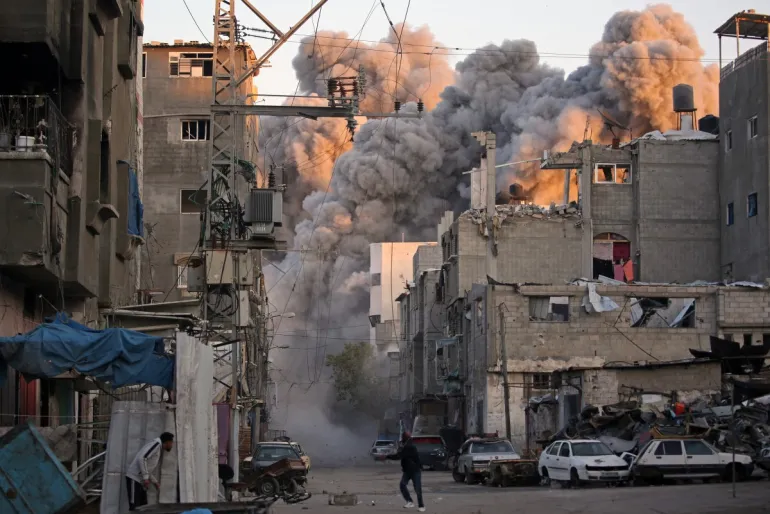Death Toll Rises as Attacks Escalate
The ongoing siege in northern Gaza has resulted in over 46,000 deaths and left more than 109,000 injured. In just the past five days, at least 70 children have lost their lives. Israeli airstrikes and ground operations have turned northern Gaza into a desolate wasteland, with schools, hospitals, and shelters facing relentless bombardment.
The humanitarian crisis in Gaza has reached catastrophic levels. Entire neighborhoods lie in ruins, and essential services have been decimated. The blockade has cut off supplies of food, water, and fuel, pushing the region to the brink of starvation. Families are living in makeshift shelters with no heating, sanitation, or clean drinking water. Aid organizations warn that without immediate intervention, the situation will lead to further loss of life and long-term trauma for the surviving population.
Civilians Face Forced Evacuations
Israeli forces continue to issue evacuation orders, warning residents in central Gaza’s Nuseirat refugee camp of potential attacks if they do not leave. Thousands of families are stranded in the open, forced to survive in makeshift tents under dire conditions. The United Nations reports famine-like circumstances, with limited access to food, water, and medical supplies.
Israeli strikes have systematically targeted infrastructure critical to civilian life. Schools have been bombed, even as they functioned as shelters for displaced families. Medical facilities, which were already overstretched, are being destroyed or ordered to evacuate. The destruction of Kamal Adwan Hospital has left northern Gaza without a functioning healthcare facility, forcing patients to seek care under impossible conditions. The targeting of these civilian structures has drawn international condemnation but continues unabated.
Hospitals Targeted Amid Humanitarian Crisis
The healthcare system in Gaza is on the brink of collapse. Kamal Adwan Hospital, a critical facility in northern Gaza, has been destroyed, leaving countless injured without treatment. Israeli strikes on shelters and hospitals have drawn widespread condemnation, yet the attacks persist.
Talks of Ceasefire and Prisoner Exchange
Negotiations for a potential ceasefire are underway, with Israel and Hamas reportedly nearing an agreement. Israeli officials, including leaders of Mossad and Shin Bet, have traveled to Qatar to advance discussions. U.S. President Joe Biden has urged for a temporary halt in hostilities to facilitate humanitarian aid and the release of hostages. However, Israeli leaders maintain that military operations will continue regardless of any agreement.
International Efforts for Ceasefire Stalled
Global diplomatic efforts to broker a ceasefire have faced significant challenges. While U.S. President Joe Biden has pushed for a temporary halt to the fighting to enable humanitarian aid and prisoner exchanges, the Israeli leadership insists on continuing its military operations. Qatar has been mediating negotiations between Israel and Hamas, with talks focusing on the release of hostages and Palestinian prisoners. Despite nearing an agreement, progress remains slow, and the violence continues.
Children and Journalists Among the Victims
The United Nations estimates that 19,000 children in Gaza have been orphaned since the start of the war. Nearly every child in Gaza requires mental health support due to the ongoing violence and displacement. The conflict has also claimed the lives of 203 journalists, with several killed in recent days.
Mental Health Crisis Among Children
The impact of the war on children in Gaza is devastating. UNICEF reports that nearly every child in Gaza now requires mental health and psychosocial support. Displacement, the constant threat of death, and the loss of family members have created a generation of children grappling with unrelenting trauma. Educational facilities are destroyed, and the ongoing violence leaves no safe spaces for children to find solace. Experts warn that the mental scars from this conflict will linger for decades.
Press Freedom Under Attack
Journalists documenting the conflict have faced deadly risks. Since the start of the war, at least 203 reporters have been killed, making it one of the deadliest conflicts for press freedom. Journalists have been caught in the crossfire while reporting on the humanitarian crisis, with many deliberately targeted during airstrikes. Media organizations have called for accountability and protection for those risking their lives to deliver the truth.
Demonstrations and Political Struggles in Israel
In Tel Aviv, thousands protested against the Israeli government, demanding an end to the war and a ceasefire deal. Prime Minister Benjamin Netanyahu faces internal challenges as far-right ministers in his coalition oppose the potential agreement. The stability of his government hangs in the balance.
Netanyahu’s Political Challenges
Prime Minister Benjamin Netanyahu’s government faces mounting pressure from within. Far-right members of his coalition oppose any ceasefire agreement, threatening to destabilize his administration. At the same time, public demonstrations in Tel Aviv reflect growing discontent among Israelis who are weary of the prolonged conflict. Balancing domestic political stability with international calls for peace presents a significant challenge for Netanyahu as he navigates this volatile period.
A Region in Despair
As the war enters its 16th month, the humanitarian situation in Gaza worsens daily. The United Nations and global organisations continue to call for an immediate end to the violence and unrestricted humanitarian access to alleviate the suffering of millions.
The international community has voiced strong criticism of the ongoing violence in Gaza. Organizations like the United Nations have called for an immediate end to hostilities, unrestricted humanitarian access, and accountability for violations of international law. Meanwhile, countries like the United States face criticism for their continued support of Israel despite the high civilian death toll. The global response to the crisis remains divided, reflecting complex geopolitical interests and alliances.
A Bleak Outlook
As the Israel– Hamas conflict rages on, the future for Gaza’s 2.3 million residents looks grim. With most of the population displaced and critical infrastructure destroyed, rebuilding the region will take years, if not decades. The prolonged siege has devastated families, communities, and livelihoods, leaving little hope for recovery unless a sustained and meaningful peace agreement is reached.

